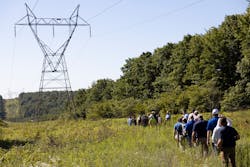Earlier this year, Pennsylvania State University (PSU), Asplundh Tree Expert, Corteva Agriscience, FirstEnergy, PECO and Tree Fund partnered together to present the ROW Sustainability Summit to dozens of vegetation management professionals serving the energy industry. Held in State College, Pennsylvania, the summit discussed and analyzed the impact different vegetation control strategies can have on environmental sustainability and wildlife habitat throughout energy rights-of-way. Additional topics of interest included ways to enhance public perception and annual resource management for vegetation management programs across the country.
The summit was spearheaded by presentations from industry experts, learning sessions and a rare field tour of the State Game Lands 33 (SGL 33) research site. Since the 1950s, SGL 33 has been used by PSU and industry research partners to test and analyze the environmental impact of vegetation management practices commonly used by vegetation management programs. Nearly 70 years of SGL 33 research has shown that the best approach to managing incompatible vegetation throughout utility rights-of-way (ROW) is an Integrated Vegetation Management (IVM) strategy.
Most vegetation control methods associated with IVM, such as mechanized mowing or biological control, are accepted by landowners and land entities. However, selective herbicide applications represent a key pillar of IVM that has been assigned an unjust stigma. While the general public commonly considers chemical treatments as environmental hazards, results from decades of SGL 33 research have indicated the opposite. In fact, findings shared at the 2022 ROW Sustainability Summit suggest that using selective herbicide applications as part of an IVM-based approach can be the key to increasing pollinator populations and supporting the development of tree-resistant ground cover that can impede incompatible tree growth throughout utility ROW.
Unlike nonselective vegetation control methods, like mechanized mowing, selective herbicide applications allow vegetation managers to effectively target incompatible vegetation without causing harm to desirable plant species. This enhances the long-term development of biodiverse wildlife habitat, which utility companies can reference to support Environmental, Social and Governance (ESG) reporting. As a result, industry leaders can achieve results that not only benefit electrical service reliability and environmental sustainability, but also their reputation and bottom line.
To learn more about SGL 33 research and the benefits IVM practices can provide throughout utility ROW and surrounding ecosystems, visit HabitatWithHerbicides.com.
™ ® Trademarks of Corteva Agriscience and its affiliated companies. © 2022 Corteva.
Sponsored By:

